Discover 15 hidden attractions, cool sights, and unusual things to do in Santa Cruz (United States). Don't miss out on these must-see attractions: Santa Cruz Surfing Museum, Giant Dipper, and Undertow Roller Coaster. Also, be sure to include Long Marine Laboratory in your itinerary.
Below, you can find the list of the most amazing places you should visit in Santa Cruz (California).
Table of Contents
Santa Cruz Surfing Museum
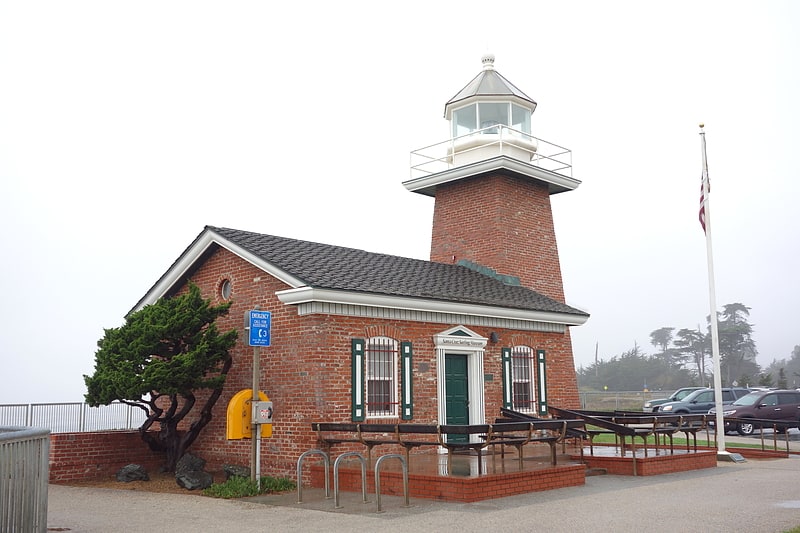
Museum in Santa Cruz, California. The Santa Cruz Surfing Museum is a museum which was established in May 1986 to document the history of surfing. With collections dating back to the earliest years of surfing on mainland United States, the museum houses a historical account of surfing in Santa Cruz, California.[1]
Address: 701 W Cliff Dr, 95060-6174 Santa Cruz
Giant Dipper
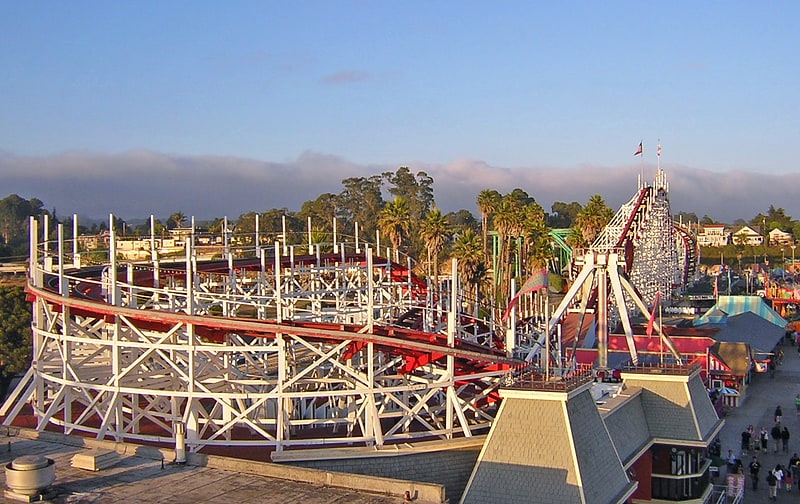
Iconic 1924 wooden roller coaster. The Giant Dipper is a historic wooden roller coaster located at the Santa Cruz Beach Boardwalk, an amusement park in Santa Cruz, California. The Giant Dipper, which replaced the Thompson's Scenic Railway, took 47 days to build and opened on May 17, 1924 at a cost of $50,000. With a height of 70 feet and a speed of 55 miles per hour, it is one of the most popular wooden roller coasters in the world. As of 2012, over 60 million people have ridden the Giant Dipper since its opening. The ride has received several awards such as being named a National Historic Landmark, a Golden Age Coaster award, and a Coaster Landmark award.[2]
Address: Santa Cruz Beach Boardwalk, 95060 Santa Cruz
Undertow Roller Coaster
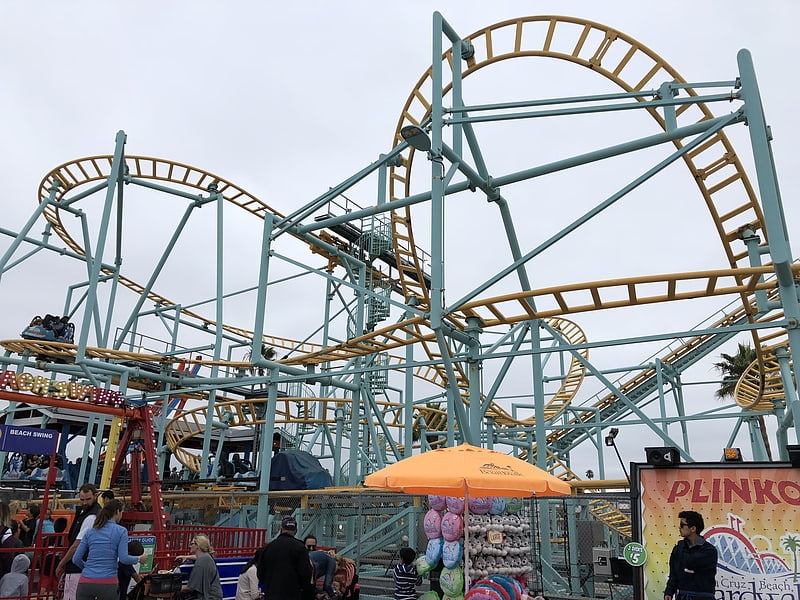
Roller coaster in Santa Cruz, California. Undertow is a steel spinning roller coaster at Santa Cruz Beach Boardwalk. The ride was built by Maurer Söhne and is the only spinning roller coaster in Northern California.[3]
Address: 400 Beach St, 95060 Santa Cruz
Long Marine Laboratory
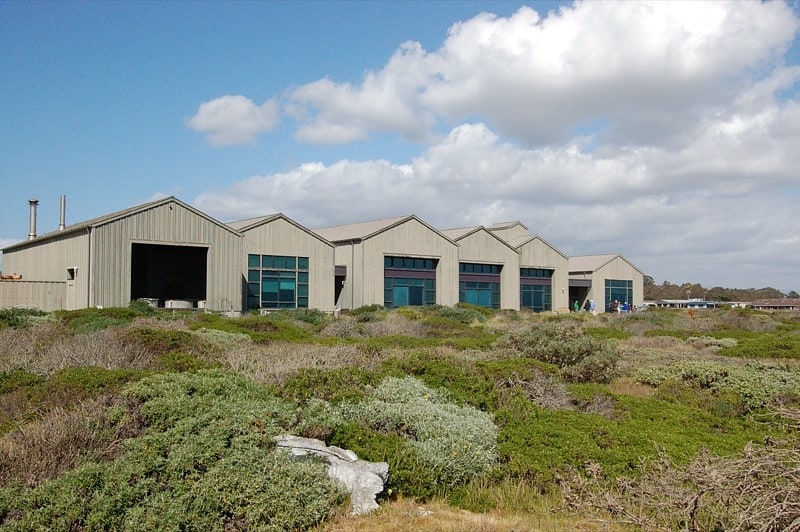
University in Santa Cruz, California. The University of California, Santa Cruz Coastal Science Campus consists of five main institutions: UCSC's Long Marine Laboratory, UCSC's Coastal Biology Building, the Southwest Fisheries Science Center, the Seymour Marine Discovery Center, and the Marine Wildlife Veterinary Care and Research Center. The physical location of the campus is at the western end of Santa Cruz, California, roughly 10 minutes away from UCSC's main campus, and is located adjacent to the Younger Lagoon Reserve. Walking trails exist throughout the campus and are used by area residents for walking, biking, and bird watching.[4]
Address: 100 McAllister Way, 95060 Santa Cruz
Mission Santa Cruz
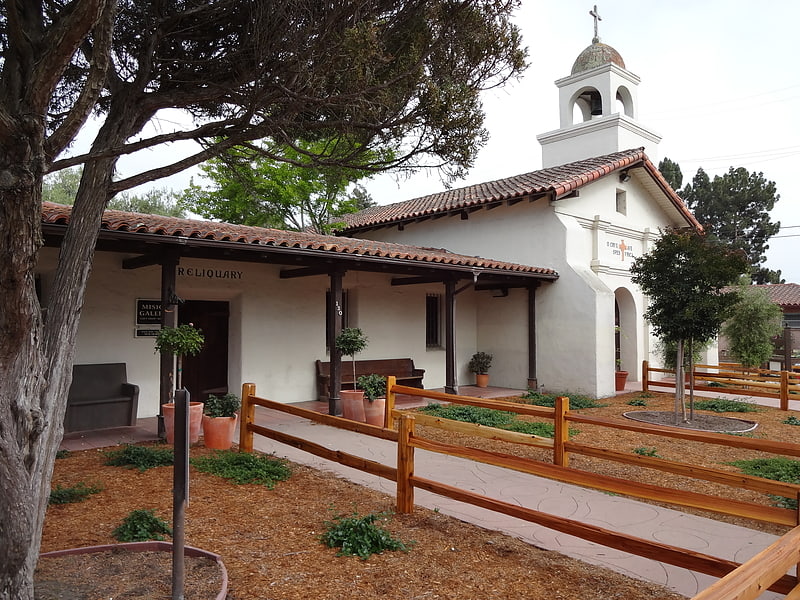
Catholic church in Santa Cruz, California. Mission Santa Cruz was a Spanish mission founded by the Franciscan order in present-day Santa Cruz, California. The mission was founded in 1791 and named for the feast of the Exaltation of the Cross, adopting the name given to a nearby creek by the missionary priest Juan Crespi, who accompanied the explorer Gaspar de Portolá when he camped on the banks of the San Lorenzo River on October 17, 1769.
As with the other California missions, Mission Santa Cruz served as a site for ecclesiastical conversion of natives, first the Amah Mutsun people, the original inhabitants of the region renamed the "Ohlone" by the Spaniards, and later the Yokuts from the east. The settlement was the site of the first autopsy in Alta California.
The current Holy Cross Church was built on the site of the original mission church in 1889, and it remains an active parish of the Diocese of Monterey. A section of stone foundation wall from one of the mission buildings and a few old headstones from the mission cemetery can be found directly behind the present Holy Cross Church. A reduced-scale "replica" chapel was built near the mission site in the 1930s and functions as a chapel of Holy Cross Church. Today's Plaza Park occupies the same location as the original plaza, at the center of the former mission complex. The complex at one time included as many as 32 buildings. The only surviving mission building, a dormitory for native acolytes, has been restored to its original appearance and functions as a museum of the Santa Cruz Mission State Historic Park.[5]
Address: 144 School St, 95060-3726 Santa Cruz (Central Santa Cruz)
Santa Cruz Breakwater Light

Lighthouse in Santa Cruz, California. Santa Cruz Breakwater Lighthouse, is a lighthouse in California, United States, in the Santa Cruz Small Craft Harbor in Santa Cruz, California.
The lighthouse is known as Walton Lighthouse because Charles Walton, a local businessman, contributed a significant part of the construction cost in memory of his late brother Derek Walton, who was a merchant seaman. The Walton lighthouse was built in 2001 with donations including $60,000 from Charles Walton.
The Santa Cruz Breakwater Lighthouse is not to be confused with the Santa Cruz Light about 1.5 miles (2.4 km) to the west above Steamer Lane.[6]
Address: Seabright Beach, 95062 Santa Cruz
Natural Bridges State Beach

State park in Santa Cruz, California. Natural Bridges State Beach is a 65-acre California state park in Santa Cruz, California, in the United States. The park features a natural bridge across a section of the beach. It is also well known as a hotspot to see monarch butterfly migrations. The Monarch Butterfly Natural Preserve is home to up to 150,000 monarch butterflies from October through early February.[7]
Address: 2531 West Cliff Dr, Santa Cruz
Small Craft Harbor
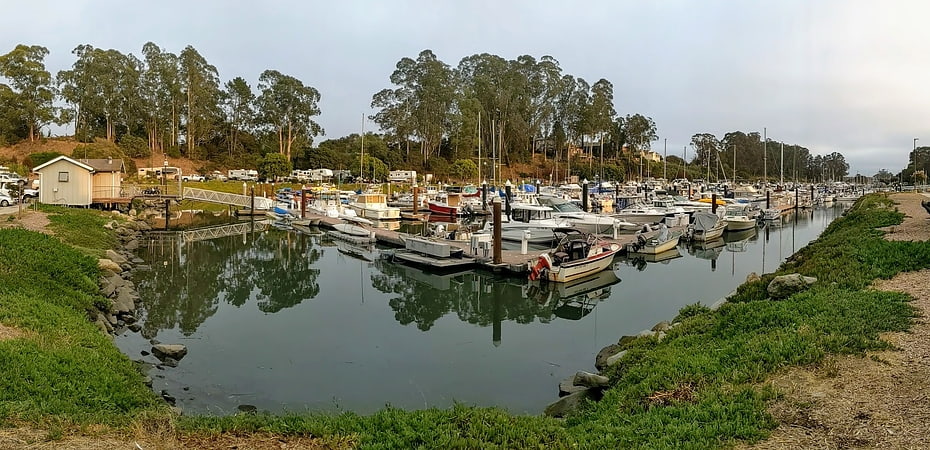
The Santa Cruz Small Craft Harbor is situated in Santa Cruz, California, on the site of the former Woods Lagoon. Built in 1962–1963, its public use specializes in boating and extracurricular marine activities for the local community and visitors. The harbor straddles the city limits which runs down the center of Arana Gulch; the west side of the harbor is in Santa Cruz's Seabright neighborhood while the east is in unincorporated Santa Cruz County.
The harbor is split into two portions: the south or "lower" harbor and the north or "upper" harbor. The lower harbor was completed first and provides slips up to 60', and is itself split into an east and a west side. The west lower harbor contains docks AA, A–F, and FF; sailboat dry storage and hoist launch; a hand launch ramp for small, lightweight craft; and a small Coast Guard facility. It is adjacent to the Santa Cruz Yacht Club. It hosts a mixture of sail and power craft, and is the location for most of the harbor's slips over 40 feet. It is accessed off of Seabright and Atlantic avenues.
The east lower harbor has docks L–T, a boatyard, the harbor offices, a launch ramp, the harbor's fuel dock, and a number of harbor-related businesses. Most of the commercial fishing fleet is berthed there, including facilities for off-loading fish. Access is from 5th Avenue and East Cliff Drive; a water taxi connects the east and west lower harbor during the summer months.
The upper harbor is separated from the lower by two fixed bridges; one carrying Murray St, the other a railroad line. Due to the limited clearance, powerboats and smaller sailboats comprise most of the boats docked in the upper harbor; many of the sailboats must lower their masts to pass under. Docks G–J and U–X provide slips to 45'. The upper harbor also contains the harbor's maintenance base, two dry storage areas, and the harbor's RV park. Access to the upper harbor is from 7th Avenue.[8]
Roaring Camp

The Roaring Camp & Big Trees Narrow Gauge Railroad is a 3 ft narrow-gauge tourist railroad in California that starts from the Roaring Camp depot in Felton, California and runs up steep grades through redwood forests to the top of nearby Bear Mountain, a distance of 3.25 miles.
Several steam engines date from the 1890s and are some of the oldest and most authentically preserved narrow-gauge steam engines still providing regular passenger service in the United States. (The Cumbres & Toltec Scenic Railroad in Colorado and New Mexico has the oldest steam engines, dating back to 1883.)
The American Society of Mechanical Engineers designated three engines at Roaring Camp and Big Trees Railroad as Historic Mechanical Engineering Landmark #134 in 1988.[9]
Santa Cruz Museum of Natural History
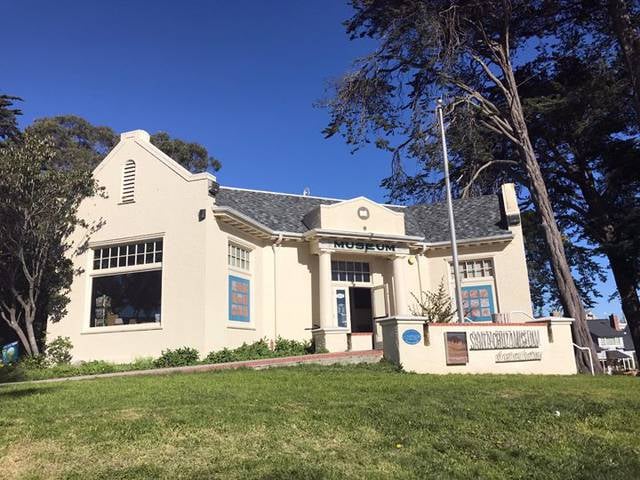
Museum, Natural history museum, History museum
Address: 1305 E Cliff Dr, 95062-3722 Santa Cruz
Santa Cruz Yacht Club
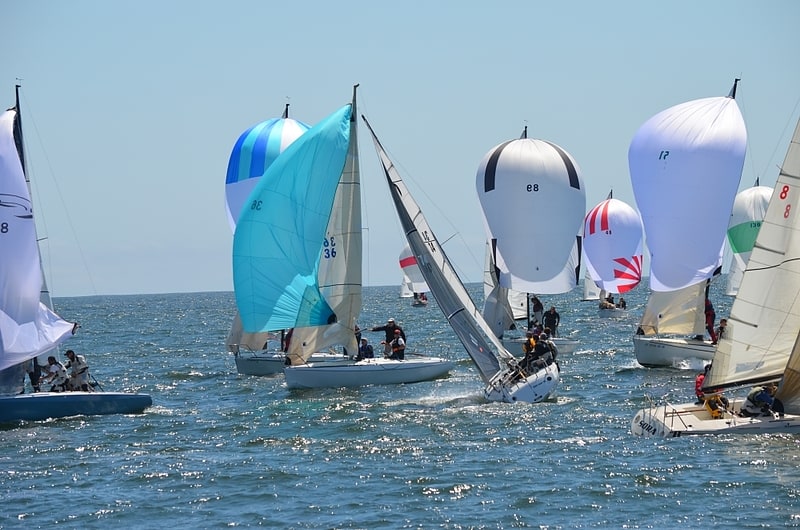
The Santa Cruz Yacht Club is a yacht club founded in 1928 and is the oldest, and currently the only, yacht club in Santa Cruz, California.[10]
McHenry Library
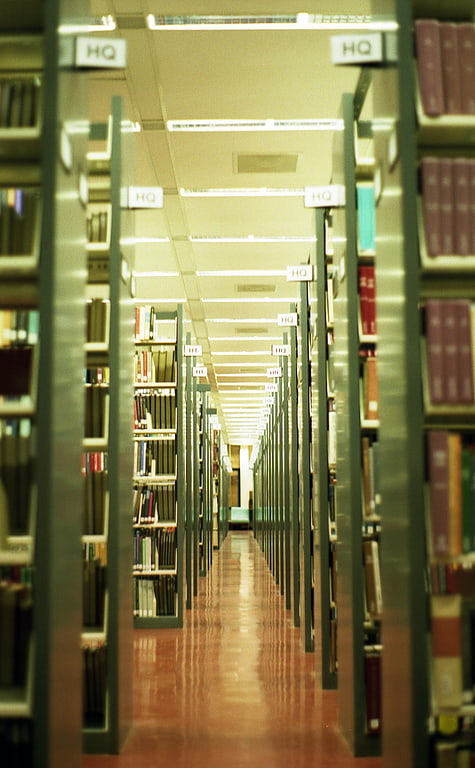
University library in Santa Cruz, California. The McHenry Library is the arts, humanities, and social sciences library of the University of California, Santa Cruz. It was named after the founding chancellor of the university, Dean E. McHenry. The building, designed by architect John Carl Warnecke, was completed in 1968 and features a minimalist design intended to blend into its forest surroundings, with floor-to-ceiling glass set in coarse, granite-like concrete and exposed vertical columns suggestive of tree trunks. The building is designed around a four-story atrium surrounded entirely by glass walls. Over the last ten years the library has undergone seismic retrofit and renovations, amounting in $100 million in improvements. In fall of 2011 it fully reopened with a new café, increased study space, and special exhibit room exclusively for the Grateful Dead archives. The Global Village Café, which is located in the new wing of the library, is run by Amazon Juices and offers smoothies, sandwiches, salads, rice bowls, and a full coffee bar.
The McHenry Library is home to the archives of the anthropologist Gregory Bateson, the rock band, The Grateful Dead, the science fiction author, Robert Heinlein, and the architectural photographer Morley Baer. The exhibit opened to the public on June 29, 2012.[11]
Address: 414 McHenry Road, Santa Cruz
Arboretum at the University of California
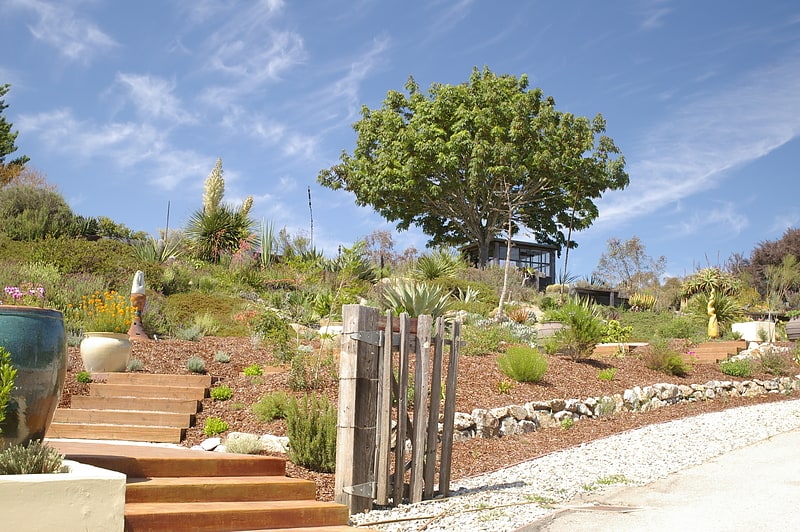
Arboretum in Santa Cruz, California. The Arboretum & Botanic Garden at the University of California, Santa Cruz, is located on the campus of the University of California, Santa Cruz, in the United States.[12]
Santa Cruz Civic Auditorium

Performing arts theater in Santa Cruz, California. The Santa Cruz Civic Auditorium is an event and convention venue located in downtown Santa Cruz, California. It is owned by the City of Santa Cruz and is located at 307 Church Street. Opened in 1940, it was built in what was described as, "Mission-style in architecture with a modern touch and an arrangement of open porches on the corners and sides." Its style has also been described as Art Deco. It is the home of the Santa Cruz County Symphony as well as other concerts, expos, conferences, and sporting events. A carillon was installed in 1963.
In 1956, the Santa Cruz Civic Auditorium was the location of a rock and roll concert that drew national attention after the local police stopped the event because of what they characterized as the dancers' "suggestive, stimulating and tantalizing motions".
The Santa Cruz Civic Auditorium was the site of the annual Miss California beauty pageant from 1966 until 1985, when the pageant left Santa Cruz after years of protests and a "Myth California" counter-pageant organized by local feminist activists led by Ann Simonton and Nikki Craft.
In 1984, artist Guillermo Wagner Granizo donated a ceramic tile mural entitled, "A Gift of Appreciation to this Area," which featured imagery of past events at the Santa Cruz Civic Auditorium.
The auditorium was used as a temporary shelter for displaced and homeless people following the 1989 Loma Prieta earthquake. It was used for this purpose again in 2020 during the CZU Lightning Complex fires.[13]
Address: 307 Church St, 95060 Santa Cruz (Central Santa Cruz)
Mystery Spot
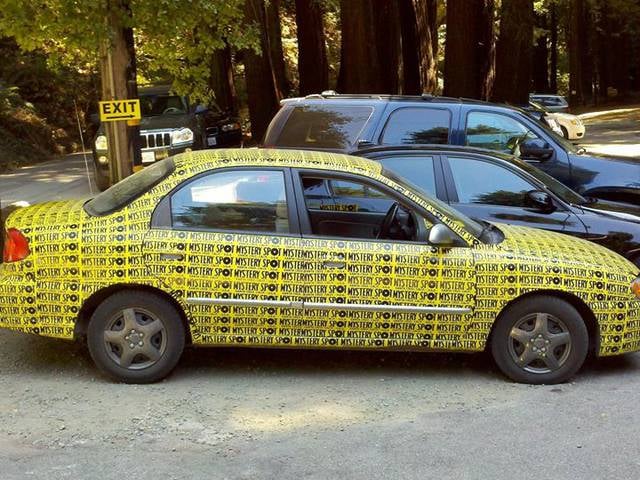
Museum, Mysterious site, Entertainment, Historical place
Address: 465 Mystery Spot Rd, 95065-9658 Santa Cruz